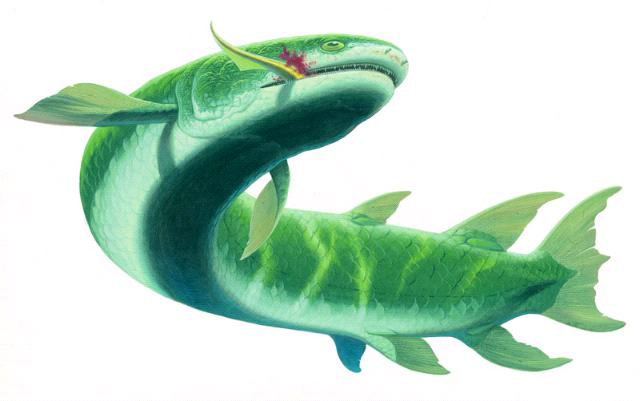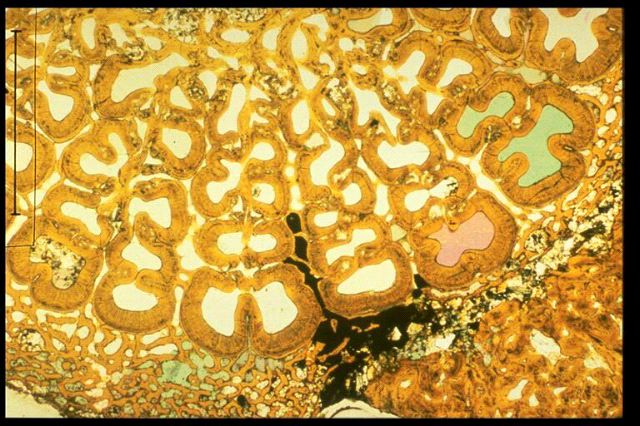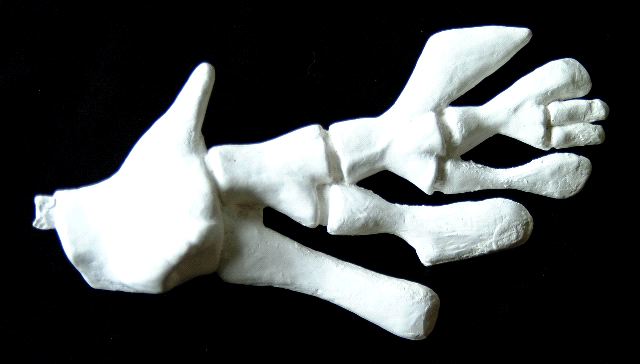Eusthenopteron

 (28 kb) The sheer abundance and excellent preservation of so many specimens of this ancient fish have allowed for numerous studies, leading to a level of recognition and fame that is usually only seen for living species.
(28 kb) The sheer abundance and excellent preservation of so many specimens of this ancient fish have allowed for numerous studies, leading to a level of recognition and fame that is usually only seen for living species.
 (44 kb)Known around the world, Eusthenopteron is sometimes called “the fish with legs”, reflecting how similar its fin bones are to those of the tetrapods. Other traits that link it closely to tetrapods are the labyrinthodont teeth (teeth with folded sheets of dentine), characteristic of primitive tetrapods, and the presence of a choana in the palate, which enabled tetrapods to breathe air. Did the choana in Eusthenopteron confer the same ability? Impossible to know for certain, but it is quite likely that the animal had lungs, as did other groups like the dipnoi.
(44 kb)Known around the world, Eusthenopteron is sometimes called “the fish with legs”, reflecting how similar its fin bones are to those of the tetrapods. Other traits that link it closely to tetrapods are the labyrinthodont teeth (teeth with folded sheets of dentine), characteristic of primitive tetrapods, and the presence of a choana in the palate, which enabled tetrapods to breathe air. Did the choana in Eusthenopteron confer the same ability? Impossible to know for certain, but it is quite likely that the animal had lungs, as did other groups like the dipnoi.
 (84 kb)The median fins of Eusthenopteron are easily recognized by their pointed sail-like shape and are positioned far back on the body, which is typical in osteolepiform fish. These fins enabled the fish to accelerate rapidly and thus surprise its prey.
(84 kb)The median fins of Eusthenopteron are easily recognized by their pointed sail-like shape and are positioned far back on the body, which is typical in osteolepiform fish. These fins enabled the fish to accelerate rapidly and thus surprise its prey.The head of Eusthenopteron displays a complex pattern of dermal bones. Small teeth adorn the edges of the upper and lower jaws, whereas pronounced fangs grew a little farther back in the mouth. It was evidently a predator, a fact that is also directly demonstrated by the presence of whole fish, sometimes even fellow members of its own species, still in the abdomen of some specimens.

 (24 kb)The streamlined profiles of this fish can reach more than a metre long, but specimens come in all sizes, some only 2.7 cm long, which has allowed an exhaustive investigation into its growth. Studies have established that it underwent at least two types of “growth spurts” during its lifetime, during which the ossification of various parts of its skeleton was accelerated.
(24 kb)The streamlined profiles of this fish can reach more than a metre long, but specimens come in all sizes, some only 2.7 cm long, which has allowed an exhaustive investigation into its growth. Studies have established that it underwent at least two types of “growth spurts” during its lifetime, during which the ossification of various parts of its skeleton was accelerated.Nicknamed the “Prince of Miguasha”, Eusthenopteron foordi has been the site’s ambassador to the world for more than a century.
The Prince of Miguasha
![]() Open this page with video (2,1mo)
Open this page with video (2,1mo)
Note : For best viewing of this site, you will need this plugins: QuickTimeDownload QuickTime
Picture Description
Japanese production of a 3D animated film showing an Eusthenopteron swimming underwater and feeding on fish and then raising its head above the water.
Site map | Feedback | Links | Sources | Credits
Eusthenopteron
<< Callistiopterus | Elpistostegalians >>

Title: Reconstruction of Eusthenopteron foordi
Author: Illustration by François Miville-Deschênes
Sources: Parc national de Miguasha
Year: 2000
Description:
The Devonian osteolepiform Eusthenopteron foordi, a swift predator with a hydrodynamic body.

Title: Eusthenopteron foordi
Author: Jean-Pierre Sylvestre
Sources: Parc national de Miguasha
Year: 2002
Description:
It was during the Devonian Period that sarcopterygian fish gave rise to the first terrestrial vertebrates. Eusthenopteron foordi (shown here) was long thought to be the transitional animal between fish and tetrapods, sharing features with both, but recent discoveries have shown that the elpistostegalians are even more closely related to four-legged vertebrates.




